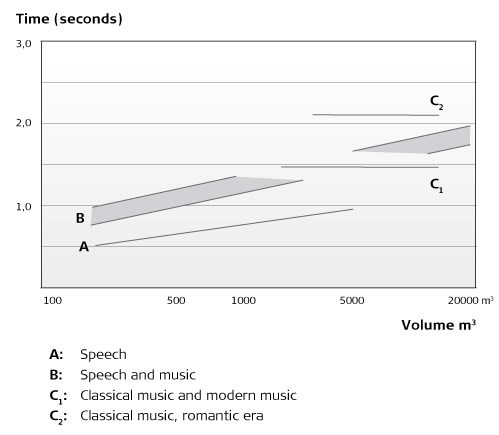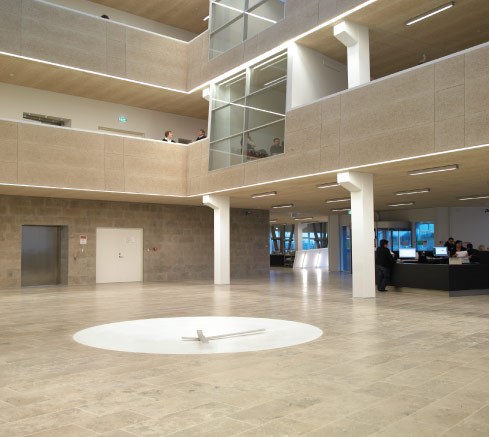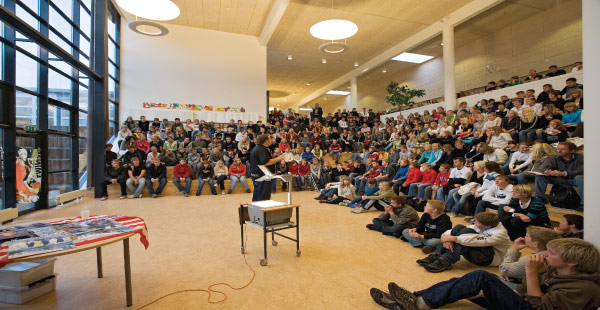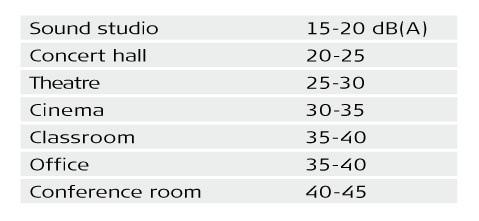An introduction to good acoustics
According to classic acoustics theory there are five requirements which, when met, result in good acoustics:
- Appropriate reverberation time depends on the size of the room. W. Furrer’s recommendations can be used in rooms which are between 200 and 20,000 cubic metres. Unless it concerns a concert hall for classical music, the reverberation time must in so as far as possible be the same throughout the entire frequency range.
- Uniform sound distribution is important in large rooms and halls, where the sound must be able to be heard equally well everywhere. It is important to take sound distribution into account in the architecture. A variation of max. ±5 dB anywhere in the room is an appropriate requirement.
- Appropriate sound level for normal conversation is 60-65 dB, and in a busy street 70-85 dB. In large gatherings, a public address system in a dampened room can be used to ensure an appropriate sound level.
- Appropriate, low background noise is one of the most important acoustic criteria – especially in concert halls and theatres. In a room, the background noise may come from technical installations or ventilation systems.
- No echo or flutter echoes must occur for the acoustics to be good. It is easy to prevent echo by installing a little sound-absorbing material on the wall.
In addition, ensuring that the sound field in the room is diffuse is another fundamental rule. This can be achieved by distributing the sound absorbers on several non-parallel surfaces, by avoiding spherical, cuboid or cylinder shapes in for the room and by using as many sound-spreading elements as possible. In addition, it must be ensured that control rooms, listening rooms and cinemas in particular are built up symmetrically around a vertical plane bisecting the central space.
What are good acoustics? In fact, is it even possible to talk about good acoustics in general terms? It is, and as acoustics are based on experience, a best practice has evolved which, when followed, results in acoustics which most people will think of as being good. By this we mean a situation where a room (and we still only talking about room acoustics) will be perceived as comfortable, well-balanced, suitably furnished for its purpose and as having a clear and distinct sound reproduction and experience.
Good acoustics are linked to human well-being. It is a question of whether you feel comfortable in the acoustic environment, whether it is at home, in a restaurant, at a concert, in the theatre or wherever. There is a lot of discussion at the moment about acoustic comfort as the subjective experience of good acoustics, which in fact is a more objective issue. Here, we will try to take a slightly closer look at which objective elements are involved. According to classic acoustics theory there are five requirements which, when met, result in good acoustics:
- an appropriate reverberation time
- uniform sound distribution
- an appropriate sound level
- an appropriately low background noise
- no echo or flutter echo
Take note of the word ‘appropriate’. It means that the individual factors must be adjusted according to the conditions. We will take them one at a time.
Appropriate reverberation time
An appropriate reverberation time results from the following: The reverberation time must be tailored to the room and the function of the room, and the reverberation time frequency spectrum should be reasonably flat and even. The exception to this is concert halls for classical music, where the reverberation time may increase slightly towards the lower frequencies. There are a number of recommendations which link the size of the room, its use and the resulting reverberation time. Here, we have followed W. Furrer’s recommendations. See Figure 16.
Here we have the room’s size (volume in cubic metres) on the horizontal axis, with several common applications as parameters. As can be seen, the diagram can be used for room sizes of approx. 200 cubic metres and up to 20,000 cubic metres. For example, a 1,000-cubic-metre room which is used for both music and talking (i.e. a multi-purpose room) should have a reverberation time of about 1.2 seconds. Spaces larger than about 20,000 cubic metres, for example some stadiums, are not suitable for the stated applications.
Figure 16: Optimum reverberation time

In addition to the reverberation time of 1.2 seconds, as mentioned there is also a requirement that this reverberation time should in so far as possible remain constant throughout the entire frequency range. In addition to the recommendations stated in the table, a number of empirical values exist which can be used as guidelines for specific applications such as sound studios, cinemas etc. The empirical values may be found in specialist literature or on the internet.
Uniform sound distribution
The requirement for uniform sound distribution is actually very banal. It is based on the fact that in large spaces such as theatres or auditoria, it must be possible to hear well everywhere, i.e. that the sound pressure level in dB only varies slightly across the audience. It is obviously very important in a theatre that everyone can hear, even those sitting right at the back. The uniform sound coverage requirement can be formulated very simply – that the sound level in the seats may only vary by a few dB, for example ± 5 dB. This can easily be ascertained using a decibel meter at selected spots, and it can also be included in the specifications for the room before work starts on designing the acoustics.
Uniform sound distribution is not just a function of how much sound absorption is installed in the room, but especially about how the sound-absorbing material is distributed, the shape of the room and whether reflectors etc. have been used. Here, the architecture of the room comes into the picture. If, for example, you have achieved the correct reverberation time with an acoustic ceiling (to meet the first of the requirements above), then the very same acoustic ceiling may cause the sound to be dampened too much across the ceiling before it reaches the seats at the very back, which is perhaps an unfortunate solution. The sound-absorbing material must therefore not necessarily be concentrated in the ceiling, but distributed across several surfaces. This is all part of the process of acoustic design, in other words getting the various acoustic requirements to harmonise with the other room requirements.
If there is also a PA system, then the key purpose of the system is to create uniform sound coverage. Troldtekt speakers, which are integrated and concealed in the Troldtekt acoustic panels, are an example of such a PA system.
As mentioned, if there is a requirement of a max. 5 dB variation in sound distribution throughout the room, this will ensure a good distribution in sound. This discussion is only relevant for large spaces such as theatres, auditoria etc.

Photo: At Hillerød City Hall, Troldtekt acoustic panels are installed on both the ceiling and walls.
Appropriate sound level
There must be a sufficiently high sound level in relation to the background noise. With the widespread use of electrically amplified music and speech, this is seldom a big problem. On the other hand, sometimes it is necessary to limit the sound, for the sake of neighbours for example.
In ordinary communication, the sound level when we speak is 60-65 dB(A) at a distance of one metre. In a busy street, the sound level on the pavement can easily reach 70-85 dB(A), so it is necessary to raise your voice or shout in order to be heard.
For people with impaired hearing, normal vocal intensity is often not enough for them to hear what is being said. In other words, it is either necessary to raise your voice, or the person in question must use a hearing aid which is designed to increase the sound level sufficiently to compensate for the hearing loss.
In large gatherings, where a speaker is addressing an audience, an appropriately dimensioned PA system in a sufficiently dampened room could certainly solve the problem of appropriate loudness and good speech intelligibility.
Low background noise
The above comments on the appropriate sound level are closely related to the need for low background noise. The difference between the available sound level (the appropriate loudness) and the inevitable background noise is called the dynamic area, and it should be as large as possible.
When talking about background noise, the focus is often on external noise sources – for example traffic noise – but background noise is also generated by technical installations such as projectors, computers and ventilation systems etc.

Photo: In refurbishing Brædstrup School, close attention was paid to the acoustics.
Read more about Brædstrup School.
It is important to pay close attention to background noise, because it can completely ruin the experience of good acoustics in a room. Therefore, it is necessary to specify requirements for background noise, and to adapt the actual requirements according to what the room is going to be used for. Usually, we do not consider this much, but in demanding situations, in other words when we have to strain our ears to hear what is being said, then the problem becomes apparent: it may be in the classroom, where it should be possible to hear the teacher, at the theatre, where the actor’s vocal intensity is a given, limiting factor, or at a restaurant, for example, where it is sometimes difficult to hear what the person sitting opposite us is saying. All three are examples of how background noise can interfere with the primary function and mar the experience.
In small rooms there are rarely problems, but as soon as we find ourselves in rooms designed for teaching, open-plan offices etc., it is important to be aware of the background noise. In really demanding venues such as theatres and concert halls, the requirement for low background noise is simply one of the most important acoustic criteria. If this is overlooked, it can be a very expensive problem.
Notice how concert halls and opera houses often have a large foyer which almost completely surrounds the auditorium.
This is not just so that the audience can enjoy a drink in the interval, but to also create a buffer zone which acoustically insulates the auditorium from the outside world.
Based on experience, the following values are recommended for the maximum acceptable background noise level:

No echo or flutter echo
Another fairly obvious issue: An acoustically good room must not have any echo or flutter echo. We all know what an echo is. When the reverberation time in a (large) room creates strong, single reflections, we perceive it as echo. Echoes may occur if you have a large smooth, hard wall at one end of an otherwise dampened room, while you are at the opposite end of the room. If you clap your hands (once), it can produce such an echo. There has to be a certain time delay for the ear to perceive this delayed sound.
The time delay must be greater than approx. 50 milliseconds, which corresponds to the sound moving approx. 17 metres. In other words, if there is more than approx. 8.5 metres to the reflecting wall, we will be able to hear an echo.
Flutter echoes are a slightly different matter. They typically occur where you have two large, smooth and hard wall surfaces which are standing parallel and opposite to one another, for example in a sports hall. If you clap your hands (once), it can produce an echo that travels backwards and forwards between the two parallel walls. It can be heard as a rapid pulse train which is reflected between the walls. Most of us will have experienced it, but without necessarily thinking about what it was. However, installing some sound-absorbing material on one of the walls will effectively remove the flutter echo. If the room does not have parallel walls, it is impossible for flutter echoes to occur.
Diffusion
We have now described the five basic requirements for good acoustics. However, there is an additional factor which has been shown to have a major impact on how we experience good acoustics – diffusion. The concept is slightly complicated to explain, as there is no actual definition, and because it is not possible to directly measure it. It relates to the fact that sound must/should be spread around the room in a random fashion. Sabine’s reverberation equation is only valid when the sound field is diffuse, so how can we ensure this when there is no fixed definition? Here, we have chosen an approach where we set up three rules of thumb, and which – if they are met – ensure adequate diffusion for Sabine’s reverberation equation to be used with reasonable accuracy. At the same time, together with the five basic rules which have been described, they are an effective recipe for good acoustics. Having a diffuse sound field in the room could be considered a sixth rule.
A diffuse sound field occurs by:
- Distributing the absorbers on several non-parallel surfaces
This means that the absorbing materials do not need to be concentrated on the ceiling and floor, for example, but instead on the ceiling and back wall. - Using as many sound-spreading elements as possible
‘Sawtooth’ profiles on walls, diffusers, furniture and general disorder – the more the better. - Using non-regular room shapes
In other words, no ball, dice or cylindrical shapes.
However, it may be difficult to avoid the box shape. - Ensuring that control rooms, listening rooms and cinemas are built up symmetrically around a horizontal plane which bisects the space.
The first two points are obviously the most important, the last two slightly more exotic.
By following these recommendations however, it is possible to design a room in which you experience good acoustics, in other words comfortable acoustics.
The first two points are obviously the most important, the last two slightly more exotic.
By following these recommendations however, it is possible to design a room in which you experience good acoustics, in other words comfortable acoustics.


